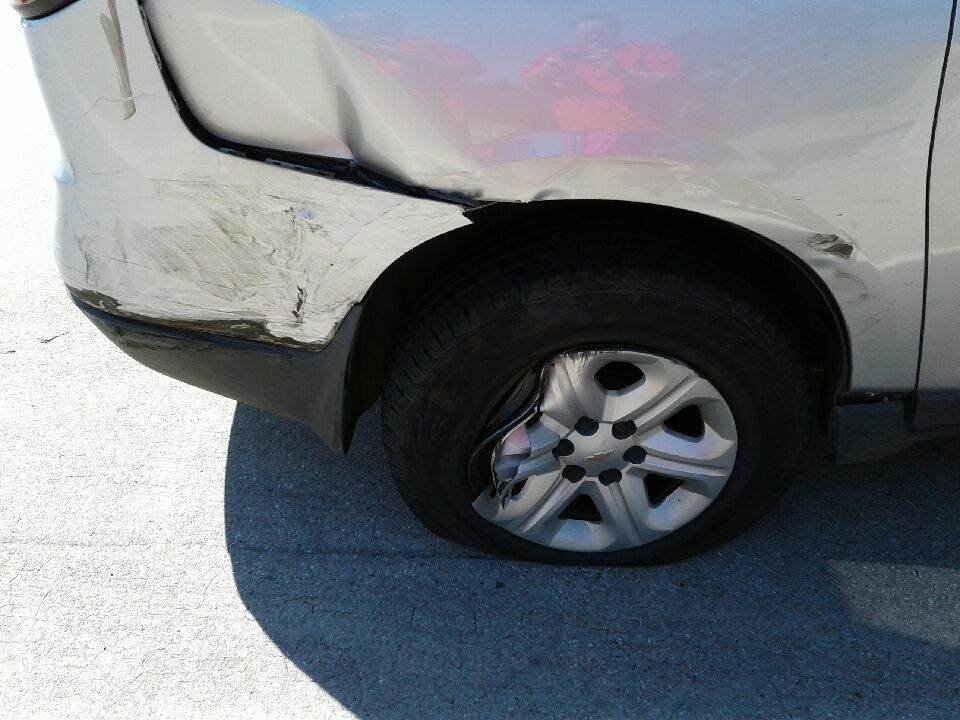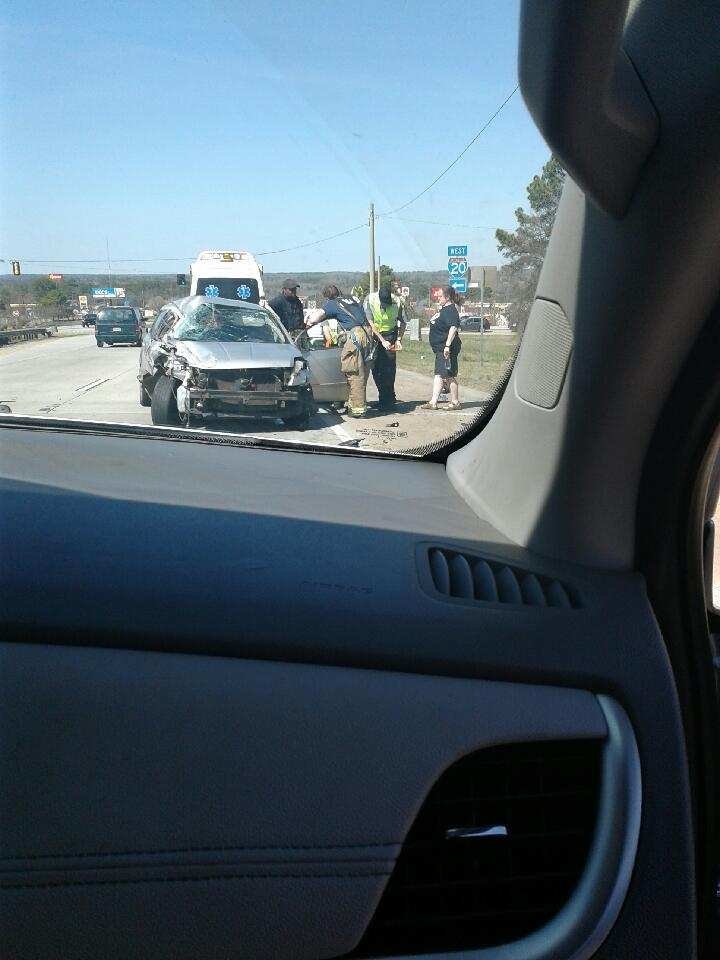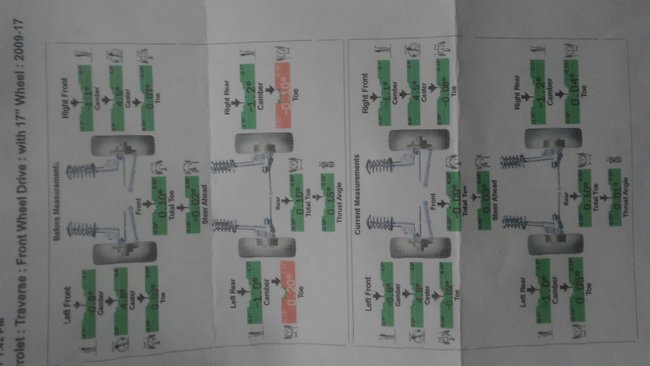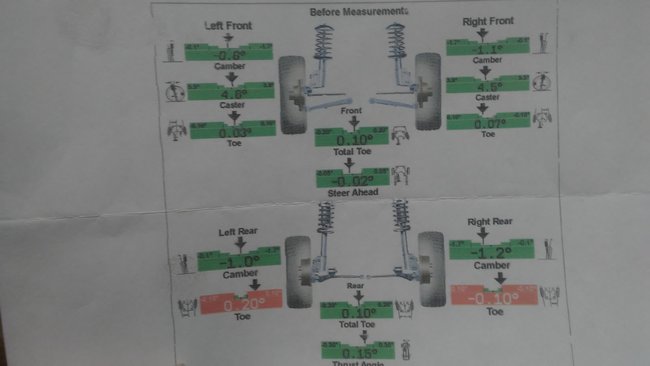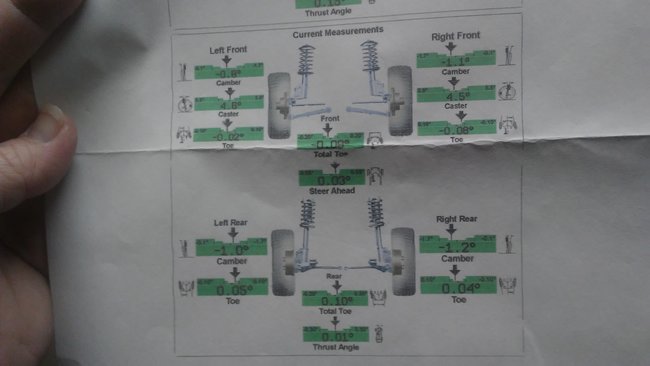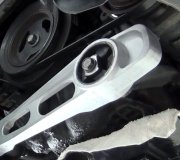I do not know how to interpret frame readings, so that you cannot find it does not matter. My friend has a body shop. When he straightens frames, (he uses the same terminology when it is a uni-body car), he uses holes punched into the sheet metal that are there to create measuring points, but he only uses them to verify the final results. Most of what he does, he pulls in various directions until the panels fit properly. I recently bought a smashed 2014 Dodge truck that was hit in the left front side. It too had the same amount of damage, ($6,500.00), but there was no frame damage, and all cosmetic stuff. Mine got all new parts though. He did use his frame machine to pull some sheet metal into place, but once finished, you could never tell the truck had been smashed.
I worked for Sears in the 1980's and also had Allstate for car insurance. As a suspension and alignment specialist, I would never put used suspension parts on my customer's cars. You have no idea what stresses were put on those parts when whatever happened to that car that put it in a salvage yard. Only a few insurance companies still insist on used parts. In the long run it usually costs them more money because they have to pay the additional labor time to clean up used parts, and when sheet metal is involved, they often insist on less-expensive aftermarket parts that do not always fit perfectly. Body shops bill the insurance companies for additional time to tweak those panels to make them fit perfectly. After all that work, those parts hold up just fine, and the insurance adjusters get a pat on the back from their supervisors for saving the company money on the cost of the parts. They do not track the added labor cost. This sounds stupid, and is probably why most insurance companies do not quibble any more about using new parts.
As for your alignment, by "knee assembly", do you mean "knuckle"? I have never heard of a "knee" on a car's suspension system. I am going to interpret these numbers as though this was the first alignment right after all the parts were replaced. If this is the second alignment and no repairs were done in between, there are a number of things that can happen to make some numbers look bad, but that's for another story. Also be aware that up to around the early 1980's, alignment equipment could measure camber angles to about 1/16 of a degree, which was plenty accurate enough for older rear-wheel-drive cars. (To put this in perspective, 0 degrees camber means that wheel is standing perfectly straight up and down, as viewed from in front of the car. 90 degrees would mean that wheel is laying flat on its outer side. Plus or minus 1/16 degree is not even close to accurate enough to eliminate a pull from most front-wheel-drive cars. All alignment computers can read accurately to plus or minus 0.01 degree, but there is another problem. Mechanics can set their computers to only display readings to plus or minus 0.1 degree. That makes their job easier but does not get the needed accuracy, especially when working on a car that is giving them problems. As an example, one popular car model specified 0.30 degrees camber for each front wheel, and from experience, I knew the left one had to be 0.06 degrees higher to offset the pull to the right from "road crown". That is that roads slant to the right so rain water runs off. The 0.30 degrees was not so critical, but the 0.06 degrees to prevent a pull was. Depending on where my settings ended up, if the computer was set to read only to 0.1 degree tolerance, it would round off the second decimal point to where my 0.06 degrees showed up as 0.1 degree or 0.0 degree. 0.1 degree is too much and will cause a pull to the left, and 0.0 degree is too little and could result in a pull to the right.
The point of this sad story is I always had my computer set up to display to two decimal places for the most accuracy. It meant I had to work harder and longer to get the perfect settings, but luckily I worked for a very nice family-owned Chrysler dealership, and no one ever yelled at me for working too slowly. My reputation was one of having very few people come back with a complaint, and the owners and my service manager valued that over speed.
Some vehicles are less picky about alignment settings and will go straight when they are not perfect.
I never aligned your model so I do not know how true that is, but in general, if it still pulls to the right after three alignment attempts, I have to wonder why the mechanic gave up without solving the problem. I do know there are some mechanics who just go by the numbers, then give the customer their car back. I would never even consider not going on a short test-drive to verify my work. I would know the pull is still there and I would not be satisfied if I knew the owner would not be satisfied.
To finally get to your numbers, any bar shown in green means that adjustment is in specs, but there is another problem. The range of acceptable settings is pretty broad. The computer can be set to shorten that range, but few of us punch that button because it makes our job that much harder. The settings have to be more precise before that bar turns from red to green. Anyway, at a glance, anything green is good to most mechanics, but the actual numbers mean more to me. Also, be aware that camber has the biggest effect on pulling to one side. Each tire wants to roll in the direction it is leaning. Most cars want a little positive camber, meaning each wheel is tipped out on top. Beyond that, it is customary to make the left a little higher than the right wheel to offset that road crown I mentioned. It looks to me like this computer was left with the broader range of tolerance that it starts out with on each alignment. The mechanic never changed it to require more precision, which is not uncommon.
Your vehicle calls for negative camber, meaning the wheels in front are tipped in on top. That is a trick Ford uses a lot to make their cars corner better, but it is very hard on tire wear and wheel bearings. The left front camber is -0.8 degrees, so that tire is pulling to the right. It is actually not set as far as it should be, so it is pulling less to the right than would be expected. That did not change between the "before" and "After" readings, so nothing was adjusted there at this alignment. The right front wheel is at -1.1 degrees which is more than specified. That will offset the -0.8 degrees on the left, and leave a 0.3 degree pull to the left. Even factoring in road crown, that is a pretty significant difference. That tells me right there your pull to the right is not alignment-related. I would expect to see the right front tire wear out on the inner edge of the tread first. That is harder to see, but it is the type of things you should be able to expect your mechanic to glance at when he is changing the oil and doing other services under the vehicle.
Caster is harder to explain, but think about how the front fork on a bicycle angles to the rear on top. Your wheels pivot at a similar angle when you turn to either side. When it comes to pulling, caster has half the effect as camber, but that only applies to rear-wheel-drive vehicles. To greatly simplify it for this discussion, the actual settings are not critical at all even if they are slightly out-of-specs. What is critical is both sides are the same. Then, that generalization goes out the window with front-wheel-drive cars. Caster has almost no noticeable effect on pulling. In fact, ninety nine percent of front-wheel-drive cars have no provision for adjusting caster. Both of your caster readings are positive. That means each wheel wants to turn toward the center of the vehicle. Put the steering linkage between them, and the two forces counteract each other, just like the two sides of a teeter totter. The left caster is 0.1 degree higher, which means it wants to pull to the right just a fuzz more than the right wheel wants to pull to the left, but as I mentioned, that is insignificant on front-wheel-drive vehicles. Your caster is fine.
"Toe" is the direction the wheels are steering when the steering wheel is perfectly straight. We do not actually set them to be parallel to the car's frame or body any more. All alignment computers perform four-wheel-alignments, and as such, they look at the direction the rear wheels are steering, and use that to tell us where to put the front wheels to make them all parallel to each other. That takes any error in the rear wheels into account to insure we end up with a straight steering wheel. Standard procedure is to set rear toe first, then front toe last to make up for any error in the rear. Your numbers in red show what needed to be adjusted, and the "After" reading of 0.01 degree rear thrust angle shows the mechanic got that set almost perfectly. That is very hard to get it that close, and in fact, it is not necessary to be that perfect. "Thrust angle" refers to how much the rear wheels are steering off to one side. It is very rare to find a thrust angle of 0.00 degrees, but yours is close.
Rear camber has little effect on pulling to one side. It is mainly a tire wear issue, and it is common to find specs calling for negative camber on a lot of cars. Since we are looking for an elusive cause of a pull, the right rear camber might be of some concern, but I have seen a lot worse that never caused a problem. That wheel is tipped in 0.2 degrees more than the left rear wheel. While I find that insignificant, changing that setting might help with the pulling problem a little. That wheel will make the rear of the car drift to the left which will turn the car to the right. To change that might require disassembling the brake and spindle to install or change a shim. Errors have to be rather significant before a mechanic will go through that much work and added expense. Changing a shim is usually done at additional cost over the cost of the alignment. It takes about a half hour per wheel.
Since I do not have experience with your model, I can only say that these "After" numbers appear to be set better than "good enough". "Good enough" meaning they are green. The arrows above each bar are very close to the center, and right at the center would be perfect.
So finally, all of this sad story boils down to my comment in my original reply; switch the two front wheels side-to-side and see if the pull goes away or is now to the left. If the pull changes, it is due to unequal rolling resistance of the tires, which is not uncommon. About half of the time the pull goes away. If it pulls left now, switch the tires front-to-rear, then leave them there until a pair wear out.
I have not mentioned other things we look for like mismatched tire sizes and brands, uneven previous wear, and unequal tire pressures. Also, this chart you posted is only one way the numbers can be displayed. This group of charts is to help the mechanic read them while squatting under the vehicle. A much more detailed listing shows only a page full of numbers that provides a lot more information. Specifically, I would like to see the numbers for "steering axis inclination" to see if they are both exactly equal. Unequal SAI can cause some weird handling problems that can be hard to diagnose. We rarely look at those numbers except when we are working on especially difficult cars.
Thursday, May 18th, 2017 AT 12:23 AM
